Skip to main content
By and photos: Onur Kurc and Tayfun Yasar 2nd March 2017
FEATURE
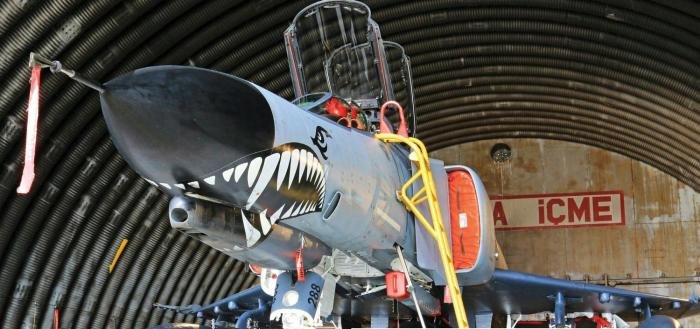
In its lair at Eskisehir is shark-mouthed 111 Filo ‘Panterler’ F-4E-2020 serial 77-0288, with an Elta EL/L-8222 jamming pod on the shoulder station.
Having undergone a major reshuffle in recent years, the Turkish Air Force has dramatically rationalized its F-4 Phantom II fleet as these warriors ultimately face retirement.
ESKISEHIR IS A city synonymous with the very essence of Turkish aviation. Located in the northwestern part of the country, the airfield has a strong link with the godfather of aeronautics in Turkey: Mustafa Kemal Atatürk. Eskisehir Air Base has housed every fast jet type operated by the Türk Hava Kuvvetleri (Turkish Air Force — THK) and still serves as the home of the 1st Air Base Command, the 1st Air Supply Maintenance Center and, most importantly, the Combat Air Force and Air Missile Defense Command — the glue that cements together all the THK combat elements.
With such a solid legacy, it comes as little surprise that Eskisehir was heavily involved with the arrival of the F-4E Phantom II in Turkish service from 1974. It is dificult to believe that the legendary Phantom II has served for nearly 43 years, and will likely continue in use until around 2020.
Phantom arrival
Turkey has always placed a huge emphasis on its armed forces due to its geographical and geopolitical location. With the country’s entry into NATO in 1952, a new aircraft with more firepower and higher performance was needed to replace the existing F-100C/D/Fs in the THK inventory. The F-4 Phantom II gained public attention during the Vietnam War and was a perfect match for Turkey’s demands at the time.
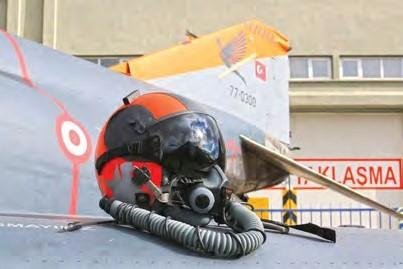
Therefore, 40 F-4Es were ordered under the ‘Peace Diamond I’ deal with the US. The era of the F-4 also heralded a step-change in air-to-ground capability with the likes of AGM-65A/B Maverick missiles, Pave Spike laser targeting pods, GBU-10/12 Paveway laser-guided bombs, electronic warfare pods and AIM-7 Sparrow medium-range air-to-air missiles. The Phantom was a major leap forward for the THK.

An F-4E flying low over the runway at Erhaç — ‘Korsanlar’ was disbanded during 2016 in the immediate aftermath of the coup attempt, although its demise was probably not linked.
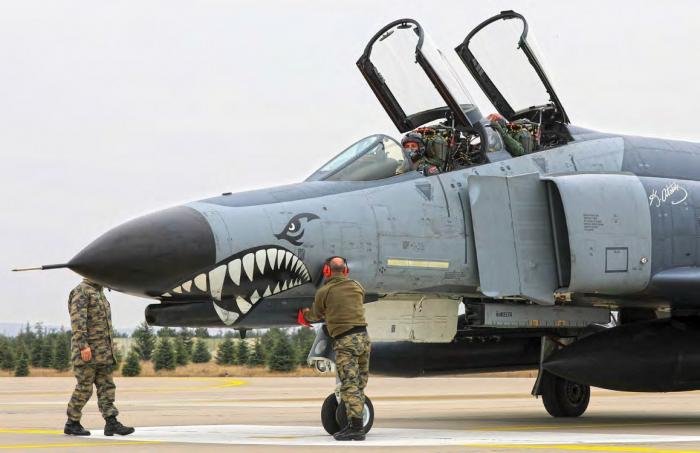
The last-chance check crew gives an Elta EL/L-8222 jamming pod-toting F-4E-2020 a final look over pre-flight.
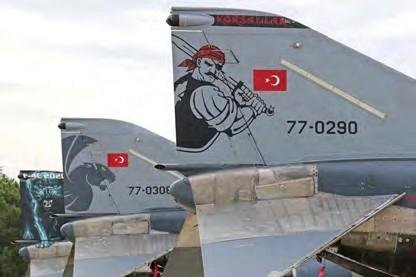
Phantom tails — 171 Filo ‘Korsanlar’ markings remain in dwindling numbers now the unit has gone. The jet in the middle wears the standard 111 Filo ‘Panterler’ tail markings.
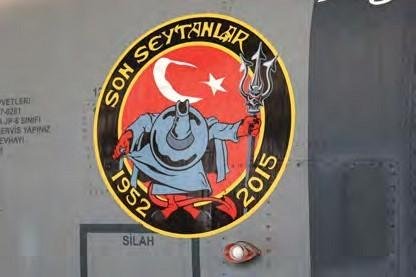
112 Filo ‘Şeytanlar’ stood down in June 2015.

The 5,000th F-4 built, serial 77-0290, still serves with 111 Filo.
The first two aircraft (serials 73-1016 and 73-1017) were flown into Eskişehir by US Air Force pilots on August 30, 1974, and delivered to 113 Filo. Tensions in Cyprus at that time resulted in the biggest combat air operation in the history of Turkish military aviation, the knock-on effect being a significant delay in the operational evolution of the F-4 in Turkey. Deliveries continued in 1975, by which time 22 aircraft equipped 112 Filo ‘Şeytanlar’ (Devils). The remaining 18, which were received after an arms embargo ended during 1977, entered service with 171 Filo ‘Korsanlar’ (Pirates) at Erhaç.
In 1978, the THK ordered a second batch of 40 aircraft, consisting of 32 F-4Es and eight RF-4Es bought under the ‘Peace Diamond II’ agreement. These joined 111 Filo ‘Panterler’ (Panthers) at Eskişehir and 172 Filo ‘Şahin’ (Hawk) at Erhaç. The charismatic RF-84Fs made way for the new RF-4Es, which equipped 113 Filo ‘Işık’ (Light) in 1980.
The story didn’t end there. Turkey was a huge fan of the F-4 and it was proving popular in service. Expansion of the fleet continued, and a further 14 F-4Es were acquired under ‘Peace Diamond III’, these joining 173 Filo ‘Şafak’ (Dawn) also at Erhaç. ‘Peace Diamond IV’ followed; it involved 15 more jets, mainly as attrition replacements, with ‘Peace Diamond V’ adding 40 surplus USAF F-4Es from October 1987. These finally saw off the remaining Super Sabres at Konya, with these Phantoms joining 131 Filo ‘Dragon’ and 132 Filo ‘Hançer’ (Dagger) here. The final batch of deliveries came shortly after the Gulf War ended in 1991, another 40 F-4Es arriving from the US under ‘Peace Diamond VI’.
The end of the Cold War and the military draw-down in northern Europe presented a new opportunity for Turkey. Surplus Luftwaffe RF-4Es were snapped up both by the THK and its neighbor Greece — 46 of these jets (including 13 held in reserve as spares sources) were delivered between 1992 and 1994. Under Project ‘Kaan’, Turkey upgraded these aircraft immediately, replacing the original AN/ APQ-99 radar systems with the newer AN/APQ-172.
These jets boosted 113 Filo at Eskişehir and enabled standardization on a fleet of 20 aircraft per squadron. The remaining examples joined 173 Filo at Erhaç, thus forming a new reconnaissance unit and pushing out the F-4Es to establish 172 Filo alongside them at Erhaç. These ex-Luftwaffe jets initially retained their three-tone ‘Norm 83’ black and green camouflage, but later received a South- East Asia green and brown scheme.
F-4E-2020 AT A GLANCE
In addition to structural work, the 54 F-4E-2020 aircraft were equipped with the Elta EL/M-2032 multi-mode fire control radar with a 144km-range, ELOP 976 wideangle head-up display (HUD), hands-on throttle and stick (HOTAS) controls, new UHF/VHF radio antennas, improved INS/ GPS navigation, new multi-function cockpit displays, flight data recorders, a new radar warning receiver (RWR) and electronic warfare upgrades. Airframe life was extended to 6,000 flight hours.
Another capability for the 2020 was the addition of the AGM-142 Popeye longrange air-to-ground missile. Whilst having the ability to carry a pair of the 3,000lb (1,361kg) weapons, operationally THK Phantoms tend to fly with a single weapon on the port inner station, plus the datalink on the opposite side.
2020 vision
Turkey has continued to invest in its Phantoms, placing a huge emphasis on depth maintenance and upgrade programs. Faced with a decision to replace or modernize the F-4s in the 1990s, it was determined that updating the F-4 was likely to require just a quarter of the cost of replacing the fleet with a new type. Israeli Aerospace Industries (IAI) signed a $632-million contract on August 24, 1995, for the upgrade of 54 F-4Es — 28 were updated by IAI at its Bedek facility, while the remainder were modernized by the 1st Air Supply Maintenance Center at Eskişehir.
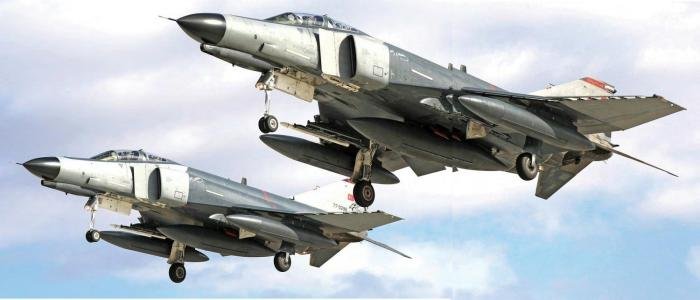
Its F-4Es having initially worn the brown and green South-East Asia camouflage, the THK standardized on ‘European One’ two-tone gray in later years.
Although the moniker ‘Terminator’ was used at the start of the project, this referred to the first squadron that received the aircraft. The upgrade was officially referred to simply as F-4E-2020, in recognition of its aim to keep the jets in front-line service until after 2020.
The first two F-4Es (serials 73-1025 and 73-1032) to undergo the upgrade were sent to Tel Aviv on February 24, 1997.
Modification of the initial example was completed on March 1, 1999, but the aircraft stayed in Israel for another year for testing and verification work. At the same time, 230 technicians slated to work on the 2020 program were trained in Israel. The first two completed F-4E-2020s (serials 73-1032 and 68-0498) were re-delivered to the 111 Filo at Eskişehir in January 2000. As the project ramped up, 171 Filo started to receive upgraded jets and from June 2002, and the program continued at Eskişehir under the auspices of the 1st Air Supply Maintenance Center until completion in July 2003. In fact, the work here was valuable to the THK and offered great experience, which proved advantageous in years to come.
Talk of a further batch of F-4E-2020s fell foul of cost and Israeli activities in Lebanon. Instead, Turkey opted to purchase 30 more F-16s.
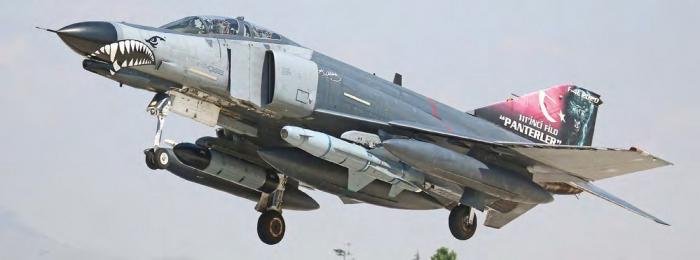
F-4E-2020 serial 77-0285 in special 111 Filo markings and carrying an AGM-142 Popeye standoff missile.
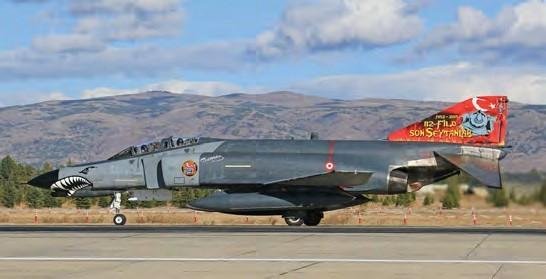
A smart F-4E-2020 of 112 Filo (69-7585) painted for the unit’s disbandment in 2015, and then transferred to 111 Filo.
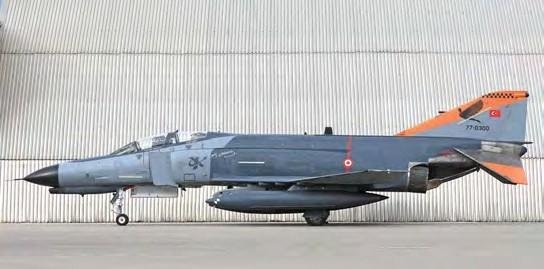
F-4E-2020 77-0300 is one of two attached to the new 401 Development Flight Test Unit under Eskişehir’s 1st Air Supply Maintenance Center Command. The unit is involved in research flight test and development activities.
THE SPECIALS
Indigenous upgrades
A more modest upgrade for 16 older F-4Es was instead completed by Aselsan from 2006, known as the ‘Simsek’ (Lightning) program. This involved 16 jets from 112 Filo, which were then known as F-4E-TM (Turkish Modernization). They received some air-to-ground targeting upgrades and improved navigation and communications kit.
After modernization at Eskişehir, the first upgraded aircraft was delivered to 112 Filo in March 2010.
Project ‘Işık’ (light) preceded this F-4ETM work and was actually the first national aircraft modernization project in Turkey.
It aimed to extend the service life of the RF-4E fleet. Aselsan led the project alongside the 1st Air Supply Maintenance Center, which made good use of its experience with the F-4E-2020 program. Seven RF-4Es from the original batch, plus 11 ex-Luftwaffe jets, received LN-100GT INS/GPS precision navigation, updated electronic warfare and CDU-900 control indicator systems, MFX-484 UHF/VHF radio, ARC-190 HF radio, and new radar warning receiver systems. In addition, five ex-Luftwaffe examples were equipped with the KS-146B LOROP (Long-Range Oblique Photography) pod, which brought the number of aircraft with the ability to carry these pods to 12 and increased the THK’s ability to acquire highresolution imagery from high altitude. The first RF-4E-TM carried out its maiden flight on December 19, 2008. The project was completed by 2010, equipping 113 and 173 Filo and earning the motto ‘Lonely, unarmed and fearless’.
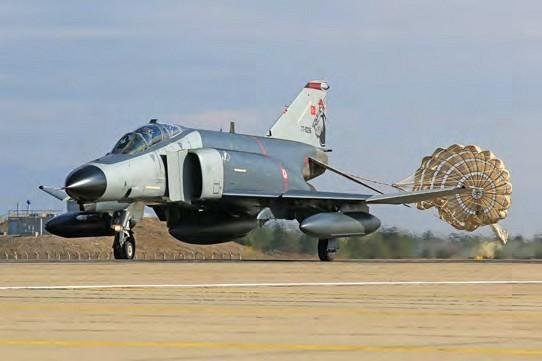
Dragging a billowing ‘chute is one of the former 171 Filo jets now assigned to 111 Filo.

The sad sight of retired F-4E-2020s and RF-4E-TMs. The storage area at the 1st Air Supply and Maintenance Center Command is known as the ‘Tired Fighters Parking Area’.
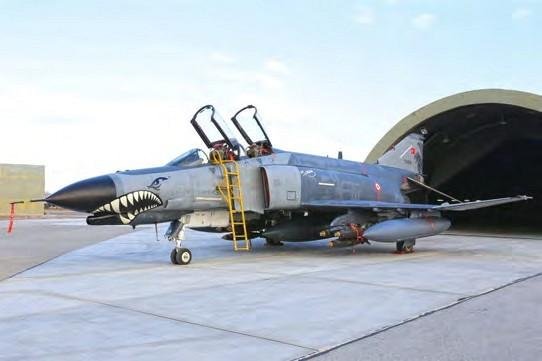
A live-armed F-4E-2020 with Mk82 iron bombs. F-4Es have flight–tested a number of new weapons in recent years including the Stand-Off Munition (SOM) from 2011, Nüfus Edici Bomba (highpenetration bomb), the Precision Guidance Kit known as Hassas Güdüm Kiti (HGK), and the Wing Assistance Guidance Kit known as Kanatlı Güdüm Kiti (KGK).
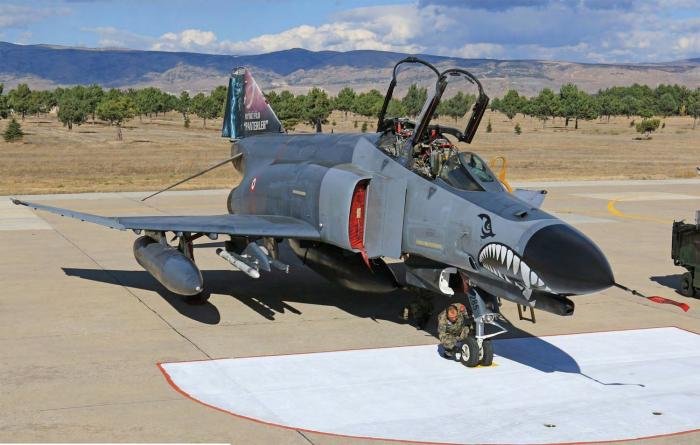
Looking as good as new despite its many years of service, 111 Filo’s flagship 77-0285 on the flightline for its next mission.
Black clouds gather
Having pressed the upgraded RF-4E-TMs into service, poor serviceability plagued these two squadrons. Low aircraft availability led directly to the decision to decommission 113 Filo on April 21, 2014, all remaining aircraft being transferred to 173 Filo.
Even so, misfortune haunted the recce squadron. On June 22, 2012, an RF-4E-TM (77-0314) was shot down by Syrian air defense systems as it flew over the eastern Mediterranean, both pilots being killed. Then, on February 24, 2015, a mid-air collision during a night mission saw the loss of four pilots.
Meanwhile, the Turkish Airborne Reconnaissance Program (TARP) had started integrating the Ultra Electronics DB-110 pod onto the F-16. Plans to retire the RF-4Es were accelerated due to the ill luck that had hit 173 Filo, and the decommissioning process of the eight remaining aircraft was brought forward. On March 12, 2015, the last reconnaissance mission was carried out by serial 77-0315 at Erhaç, bringing an end to the recce Phantom’s service in Turkey.
The situation with the RF-4s was actually being mirrored elsewhere. Age was hitting the THK F-4 inventory fast — even the upgraded F-4E-2020s. The F-4E-TMs were withdrawn, and soon the dwindling fleet of F-4E-2020s was in high demand.
In 2014, 132 Filo ‘Hançer’ stepped out of the F-4 world, donating its ‘2020s’ to 111 Filo ‘Panterler’ at Eskisehir and 171 Filo ‘Korsanlar’ at Erhaç. 112 Filo ‘Seytanlar’ stood down in June 2015, its F-4E-2020s also being sent to ‘Panterler’.
The net result of all the reshuffling and retirements was that, by early 2016, just two THK squadrons continued to fly the F-4 — ‘Panterler’ at Eskişehir and ‘Korsanlar’ at Erhaç.
Things were about to get even worse for the Turkish Phantoms. Straight after an attempted coup d’etat against the Turkish government on July 15, 2016, 171 Filo was shut down as a widespread reorganization hit the THK. 111 Filo ‘Panterler’ was spared and today stands as the only Turkish F-4 unit, flying the remaining F-4E-2020s and still based at Eskişehir.
From a total of 236 Phantom IIs delivered to Turkey, which once served with nine squadrons at three main jet bases, just a handful now linger.
Turkey has become a major operator of the F-16, but it has its sights firmly fixed on the F-35 Lightning II, as well as the indigenous TF-X fighter program.
The last F-4s are acting as an insurance policy against slippage in these new projects. With the THK’s first F-35s due this year, the Phantoms could see service for a few years yet. The official line is still, appropriately, 2020.
A sad-looking dump area for decommissioned Phantoms is now a telling barometer of the situation at 1 Air Supply and Maintenance Center. While the draw-down has been swift but relatively un-noticed in recent years, the F-4E-2020 still has some life left. The aircraft have recently been at the forefront of combat operations over the Syrian border and are continuing to prove their worth, despite their age.
‘PANTERLER’ OPS
Established at Eskişehir in 1954, 111 Filo ‘Panterler’ has been equipped with the F-4E-2020 since January 2000. The unit retains around 40 aircraft today, and it is planned to be re-equipped with F-35 Lightning IIs after 2020.
The squadron maintains an active front-line role, and has been engaged in joint operations over Syria with Russia. It was also involved in suppressing the coup d’etat attempt last year. The squadron’s F-4E-2020s prevented air strikes by taking out the main runway of the 4th Main Jet Base, which was used as the main center of the coup attempt in Ankara.

- List additional actions
LAST OF THE TURKISH PHANTOMS
- Aviation Features
- LAST OF THE TURKISH PHANTOMS
By and photos: Onur Kurc and Tayfun Yasar 2nd March 2017
FEATURE

In its lair at Eskisehir is shark-mouthed 111 Filo ‘Panterler’ F-4E-2020 serial 77-0288, with an Elta EL/L-8222 jamming pod on the shoulder station.
Having undergone a major reshuffle in recent years, the Turkish Air Force has dramatically rationalized its F-4 Phantom II fleet as these warriors ultimately face retirement.
ESKISEHIR IS A city synonymous with the very essence of Turkish aviation. Located in the northwestern part of the country, the airfield has a strong link with the godfather of aeronautics in Turkey: Mustafa Kemal Atatürk. Eskisehir Air Base has housed every fast jet type operated by the Türk Hava Kuvvetleri (Turkish Air Force — THK) and still serves as the home of the 1st Air Base Command, the 1st Air Supply Maintenance Center and, most importantly, the Combat Air Force and Air Missile Defense Command — the glue that cements together all the THK combat elements.
With such a solid legacy, it comes as little surprise that Eskisehir was heavily involved with the arrival of the F-4E Phantom II in Turkish service from 1974. It is dificult to believe that the legendary Phantom II has served for nearly 43 years, and will likely continue in use until around 2020.
Phantom arrival
Turkey has always placed a huge emphasis on its armed forces due to its geographical and geopolitical location. With the country’s entry into NATO in 1952, a new aircraft with more firepower and higher performance was needed to replace the existing F-100C/D/Fs in the THK inventory. The F-4 Phantom II gained public attention during the Vietnam War and was a perfect match for Turkey’s demands at the time.

Therefore, 40 F-4Es were ordered under the ‘Peace Diamond I’ deal with the US. The era of the F-4 also heralded a step-change in air-to-ground capability with the likes of AGM-65A/B Maverick missiles, Pave Spike laser targeting pods, GBU-10/12 Paveway laser-guided bombs, electronic warfare pods and AIM-7 Sparrow medium-range air-to-air missiles. The Phantom was a major leap forward for the THK.

An F-4E flying low over the runway at Erhaç — ‘Korsanlar’ was disbanded during 2016 in the immediate aftermath of the coup attempt, although its demise was probably not linked.

The last-chance check crew gives an Elta EL/L-8222 jamming pod-toting F-4E-2020 a final look over pre-flight.

Phantom tails — 171 Filo ‘Korsanlar’ markings remain in dwindling numbers now the unit has gone. The jet in the middle wears the standard 111 Filo ‘Panterler’ tail markings.

112 Filo ‘Şeytanlar’ stood down in June 2015.

The 5,000th F-4 built, serial 77-0290, still serves with 111 Filo.
The first two aircraft (serials 73-1016 and 73-1017) were flown into Eskişehir by US Air Force pilots on August 30, 1974, and delivered to 113 Filo. Tensions in Cyprus at that time resulted in the biggest combat air operation in the history of Turkish military aviation, the knock-on effect being a significant delay in the operational evolution of the F-4 in Turkey. Deliveries continued in 1975, by which time 22 aircraft equipped 112 Filo ‘Şeytanlar’ (Devils). The remaining 18, which were received after an arms embargo ended during 1977, entered service with 171 Filo ‘Korsanlar’ (Pirates) at Erhaç.
In 1978, the THK ordered a second batch of 40 aircraft, consisting of 32 F-4Es and eight RF-4Es bought under the ‘Peace Diamond II’ agreement. These joined 111 Filo ‘Panterler’ (Panthers) at Eskişehir and 172 Filo ‘Şahin’ (Hawk) at Erhaç. The charismatic RF-84Fs made way for the new RF-4Es, which equipped 113 Filo ‘Işık’ (Light) in 1980.
The story didn’t end there. Turkey was a huge fan of the F-4 and it was proving popular in service. Expansion of the fleet continued, and a further 14 F-4Es were acquired under ‘Peace Diamond III’, these joining 173 Filo ‘Şafak’ (Dawn) also at Erhaç. ‘Peace Diamond IV’ followed; it involved 15 more jets, mainly as attrition replacements, with ‘Peace Diamond V’ adding 40 surplus USAF F-4Es from October 1987. These finally saw off the remaining Super Sabres at Konya, with these Phantoms joining 131 Filo ‘Dragon’ and 132 Filo ‘Hançer’ (Dagger) here. The final batch of deliveries came shortly after the Gulf War ended in 1991, another 40 F-4Es arriving from the US under ‘Peace Diamond VI’.
The end of the Cold War and the military draw-down in northern Europe presented a new opportunity for Turkey. Surplus Luftwaffe RF-4Es were snapped up both by the THK and its neighbor Greece — 46 of these jets (including 13 held in reserve as spares sources) were delivered between 1992 and 1994. Under Project ‘Kaan’, Turkey upgraded these aircraft immediately, replacing the original AN/ APQ-99 radar systems with the newer AN/APQ-172.
These jets boosted 113 Filo at Eskişehir and enabled standardization on a fleet of 20 aircraft per squadron. The remaining examples joined 173 Filo at Erhaç, thus forming a new reconnaissance unit and pushing out the F-4Es to establish 172 Filo alongside them at Erhaç. These ex-Luftwaffe jets initially retained their three-tone ‘Norm 83’ black and green camouflage, but later received a South- East Asia green and brown scheme.
F-4E-2020 AT A GLANCE
In addition to structural work, the 54 F-4E-2020 aircraft were equipped with the Elta EL/M-2032 multi-mode fire control radar with a 144km-range, ELOP 976 wideangle head-up display (HUD), hands-on throttle and stick (HOTAS) controls, new UHF/VHF radio antennas, improved INS/ GPS navigation, new multi-function cockpit displays, flight data recorders, a new radar warning receiver (RWR) and electronic warfare upgrades. Airframe life was extended to 6,000 flight hours.
Another capability for the 2020 was the addition of the AGM-142 Popeye longrange air-to-ground missile. Whilst having the ability to carry a pair of the 3,000lb (1,361kg) weapons, operationally THK Phantoms tend to fly with a single weapon on the port inner station, plus the datalink on the opposite side.
2020 vision
Turkey has continued to invest in its Phantoms, placing a huge emphasis on depth maintenance and upgrade programs. Faced with a decision to replace or modernize the F-4s in the 1990s, it was determined that updating the F-4 was likely to require just a quarter of the cost of replacing the fleet with a new type. Israeli Aerospace Industries (IAI) signed a $632-million contract on August 24, 1995, for the upgrade of 54 F-4Es — 28 were updated by IAI at its Bedek facility, while the remainder were modernized by the 1st Air Supply Maintenance Center at Eskişehir.

Its F-4Es having initially worn the brown and green South-East Asia camouflage, the THK standardized on ‘European One’ two-tone gray in later years.
Although the moniker ‘Terminator’ was used at the start of the project, this referred to the first squadron that received the aircraft. The upgrade was officially referred to simply as F-4E-2020, in recognition of its aim to keep the jets in front-line service until after 2020.
The first two F-4Es (serials 73-1025 and 73-1032) to undergo the upgrade were sent to Tel Aviv on February 24, 1997.
Modification of the initial example was completed on March 1, 1999, but the aircraft stayed in Israel for another year for testing and verification work. At the same time, 230 technicians slated to work on the 2020 program were trained in Israel. The first two completed F-4E-2020s (serials 73-1032 and 68-0498) were re-delivered to the 111 Filo at Eskişehir in January 2000. As the project ramped up, 171 Filo started to receive upgraded jets and from June 2002, and the program continued at Eskişehir under the auspices of the 1st Air Supply Maintenance Center until completion in July 2003. In fact, the work here was valuable to the THK and offered great experience, which proved advantageous in years to come.
Talk of a further batch of F-4E-2020s fell foul of cost and Israeli activities in Lebanon. Instead, Turkey opted to purchase 30 more F-16s.

F-4E-2020 serial 77-0285 in special 111 Filo markings and carrying an AGM-142 Popeye standoff missile.

A smart F-4E-2020 of 112 Filo (69-7585) painted for the unit’s disbandment in 2015, and then transferred to 111 Filo.

F-4E-2020 77-0300 is one of two attached to the new 401 Development Flight Test Unit under Eskişehir’s 1st Air Supply Maintenance Center Command. The unit is involved in research flight test and development activities.
THE SPECIALS
Indigenous upgrades
A more modest upgrade for 16 older F-4Es was instead completed by Aselsan from 2006, known as the ‘Simsek’ (Lightning) program. This involved 16 jets from 112 Filo, which were then known as F-4E-TM (Turkish Modernization). They received some air-to-ground targeting upgrades and improved navigation and communications kit.
After modernization at Eskişehir, the first upgraded aircraft was delivered to 112 Filo in March 2010.
Project ‘Işık’ (light) preceded this F-4ETM work and was actually the first national aircraft modernization project in Turkey.
It aimed to extend the service life of the RF-4E fleet. Aselsan led the project alongside the 1st Air Supply Maintenance Center, which made good use of its experience with the F-4E-2020 program. Seven RF-4Es from the original batch, plus 11 ex-Luftwaffe jets, received LN-100GT INS/GPS precision navigation, updated electronic warfare and CDU-900 control indicator systems, MFX-484 UHF/VHF radio, ARC-190 HF radio, and new radar warning receiver systems. In addition, five ex-Luftwaffe examples were equipped with the KS-146B LOROP (Long-Range Oblique Photography) pod, which brought the number of aircraft with the ability to carry these pods to 12 and increased the THK’s ability to acquire highresolution imagery from high altitude. The first RF-4E-TM carried out its maiden flight on December 19, 2008. The project was completed by 2010, equipping 113 and 173 Filo and earning the motto ‘Lonely, unarmed and fearless’.

Dragging a billowing ‘chute is one of the former 171 Filo jets now assigned to 111 Filo.

The sad sight of retired F-4E-2020s and RF-4E-TMs. The storage area at the 1st Air Supply and Maintenance Center Command is known as the ‘Tired Fighters Parking Area’.

A live-armed F-4E-2020 with Mk82 iron bombs. F-4Es have flight–tested a number of new weapons in recent years including the Stand-Off Munition (SOM) from 2011, Nüfus Edici Bomba (highpenetration bomb), the Precision Guidance Kit known as Hassas Güdüm Kiti (HGK), and the Wing Assistance Guidance Kit known as Kanatlı Güdüm Kiti (KGK).

Looking as good as new despite its many years of service, 111 Filo’s flagship 77-0285 on the flightline for its next mission.
Black clouds gather
Having pressed the upgraded RF-4E-TMs into service, poor serviceability plagued these two squadrons. Low aircraft availability led directly to the decision to decommission 113 Filo on April 21, 2014, all remaining aircraft being transferred to 173 Filo.
Even so, misfortune haunted the recce squadron. On June 22, 2012, an RF-4E-TM (77-0314) was shot down by Syrian air defense systems as it flew over the eastern Mediterranean, both pilots being killed. Then, on February 24, 2015, a mid-air collision during a night mission saw the loss of four pilots.
Meanwhile, the Turkish Airborne Reconnaissance Program (TARP) had started integrating the Ultra Electronics DB-110 pod onto the F-16. Plans to retire the RF-4Es were accelerated due to the ill luck that had hit 173 Filo, and the decommissioning process of the eight remaining aircraft was brought forward. On March 12, 2015, the last reconnaissance mission was carried out by serial 77-0315 at Erhaç, bringing an end to the recce Phantom’s service in Turkey.
The situation with the RF-4s was actually being mirrored elsewhere. Age was hitting the THK F-4 inventory fast — even the upgraded F-4E-2020s. The F-4E-TMs were withdrawn, and soon the dwindling fleet of F-4E-2020s was in high demand.
In 2014, 132 Filo ‘Hançer’ stepped out of the F-4 world, donating its ‘2020s’ to 111 Filo ‘Panterler’ at Eskisehir and 171 Filo ‘Korsanlar’ at Erhaç. 112 Filo ‘Seytanlar’ stood down in June 2015, its F-4E-2020s also being sent to ‘Panterler’.
The net result of all the reshuffling and retirements was that, by early 2016, just two THK squadrons continued to fly the F-4 — ‘Panterler’ at Eskişehir and ‘Korsanlar’ at Erhaç.
Things were about to get even worse for the Turkish Phantoms. Straight after an attempted coup d’etat against the Turkish government on July 15, 2016, 171 Filo was shut down as a widespread reorganization hit the THK. 111 Filo ‘Panterler’ was spared and today stands as the only Turkish F-4 unit, flying the remaining F-4E-2020s and still based at Eskişehir.
From a total of 236 Phantom IIs delivered to Turkey, which once served with nine squadrons at three main jet bases, just a handful now linger.
Turkey has become a major operator of the F-16, but it has its sights firmly fixed on the F-35 Lightning II, as well as the indigenous TF-X fighter program.
The last F-4s are acting as an insurance policy against slippage in these new projects. With the THK’s first F-35s due this year, the Phantoms could see service for a few years yet. The official line is still, appropriately, 2020.
A sad-looking dump area for decommissioned Phantoms is now a telling barometer of the situation at 1 Air Supply and Maintenance Center. While the draw-down has been swift but relatively un-noticed in recent years, the F-4E-2020 still has some life left. The aircraft have recently been at the forefront of combat operations over the Syrian border and are continuing to prove their worth, despite their age.
‘PANTERLER’ OPS
Established at Eskişehir in 1954, 111 Filo ‘Panterler’ has been equipped with the F-4E-2020 since January 2000. The unit retains around 40 aircraft today, and it is planned to be re-equipped with F-35 Lightning IIs after 2020.
The squadron maintains an active front-line role, and has been engaged in joint operations over Syria with Russia. It was also involved in suppressing the coup d’etat attempt last year. The squadron’s F-4E-2020s prevented air strikes by taking out the main runway of the 4th Main Jet Base, which was used as the main center of the coup attempt in Ankara.











